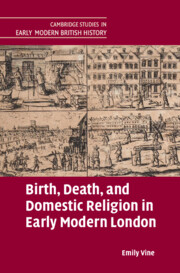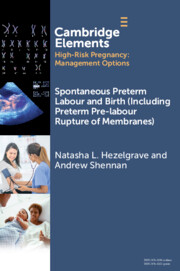Refine search
Actions for selected content:
55 results
Conclusion
-
- Book:
- Birth, Death, and Domestic Religion in Early Modern London
- Published online:
- 17 July 2025
- Print publication:
- 31 July 2025, pp 217-226
-
- Chapter
- Export citation
Introduction
-
- Book:
- Birth, Death, and Domestic Religion in Early Modern London
- Published online:
- 17 July 2025
- Print publication:
- 31 July 2025, pp 1-27
-
- Chapter
- Export citation

Birth, Death, and Domestic Religion in Early Modern London
-
- Published online:
- 17 July 2025
- Print publication:
- 31 July 2025
Chapter 17 - Seeking Parteras in the Archive
- from Part V - Labor
-
-
- Book:
- Latinx Literature in Transition, 1848–1992
- Published online:
- 10 April 2025
- Print publication:
- 17 April 2025, pp 297-314
-
- Chapter
- Export citation

Spontaneous Preterm Labour and Birth (Including Preterm Pre-labour Rupture of Membranes)
-
- Published online:
- 15 January 2025
- Print publication:
- 30 January 2025
-
- Element
- Export citation
De-gendering and De-sexing Motherhood
-
- Article
-
- You have access
- Open access
- HTML
- Export citation
5 - Sex and the Altepetl
-
- Book:
- A Concise History of the Aztecs
- Published online:
- 08 February 2024
- Print publication:
- 15 February 2024, pp 158-201
-
- Chapter
- Export citation
1 - Alexander’s Birth and Childhood
- from Part I - Alexander’s Life and Career
-
-
- Book:
- The Cambridge Companion to Alexander the Great
- Published online:
- 04 January 2024
- Print publication:
- 18 January 2024, pp 29-41
-
- Chapter
- Export citation
Birth: A radically new meditation for philosophy
-
- Article
-
- You have access
- Open access
- HTML
- Export citation
Chapter 1 - Taking Shape
-
- Book:
- The Life Course in Old English Poetry
- Published online:
- 29 November 2023
- Print publication:
- 07 December 2023, pp 25-60
-
- Chapter
- Export citation
1 - Stories of the Buddha
-
- Book:
- The Buddha
- Published online:
- 09 November 2023
- Print publication:
- 30 November 2023, pp 7-43
-
- Chapter
- Export citation
9 - Demography and Group Dynamics of Western Hoolock Gibbons (Hoolock hoolock) in a Community Conserved Village Population in Upper Assam, India
-
-
- Book:
- Gibbon Conservation in the Anthropocene
- Published online:
- 13 April 2023
- Print publication:
- 20 April 2023, pp 131-146
-
- Chapter
- Export citation
Genetic parameters for birth difficulty, lamb vigour and lamb sucking ability in Suffolk sheep
-
- Journal:
- Animal Welfare / Volume 19 / Issue S1 / May 2010
- Published online by Cambridge University Press:
- 01 January 2023, pp. 99-105
-
- Article
- Export citation
2 - A Narrow Escape
-
- Book:
- What Makes a Person?
- Published online:
- 03 November 2022
- Print publication:
- 03 November 2022, pp 38-65
-
- Chapter
- Export citation
8 - Anxiety About Pregnancy and Birth
-
- Book:
- Break Free from Maternal Anxiety
- Published online:
- 13 October 2022
- Print publication:
- 13 October 2022, pp 256-302
-
- Chapter
- Export citation
Random population dynamics under catastrophic events
- Part of
-
- Journal:
- Journal of Applied Probability / Volume 59 / Issue 4 / December 2022
- Published online by Cambridge University Press:
- 15 August 2022, pp. 962-982
- Print publication:
- December 2022
-
- Article
- Export citation
Reproductive success of Antillean manatees released in Brazil: implications for conservation
-
- Journal:
- Journal of the Marine Biological Association of the United Kingdom / Volume 102 / Issue 3-4 / June 2022
- Published online by Cambridge University Press:
- 26 July 2022, pp. 252-259
-
- Article
- Export citation
3 - Baby Seekers/Baby Lovers
-
- Book:
- China's Grandmothers
- Published online:
- 14 April 2022
- Print publication:
- 21 April 2022, pp 34-53
-
- Chapter
- Export citation
2 - Controlling Reproduction and Motherhood
-
- Book:
- Gender and Sexuality in Modern Japan
- Published online:
- 24 March 2022
- Print publication:
- 31 March 2022, pp 47-69
-
- Chapter
- Export citation
Framing Black Infant and Maternal Mortality
-
- Journal:
- Journal of Law, Medicine & Ethics / Volume 50 / Issue 1 / Spring 2022
- Published online by Cambridge University Press:
- 04 March 2022, pp. 85-91
- Print publication:
- Spring 2022
-
- Article
- Export citation
